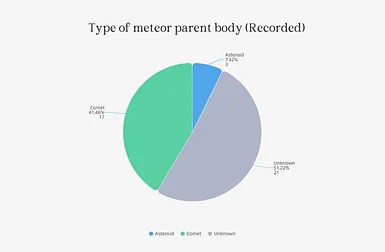Elina Zhong 钟以恒 Kira Zhang 张晴钰 Blanche Hu 胡钟元

Introduction
We are brought together by a common interest – astronomy. Meteor showers are a particularly romantic branch of astronomy. A meteor is a’shooting star,’ a streak of light that streaks across the sky in less than a second, to most ordinary people. In fact, any observer can see between 2 and 7 meteors per hour under a dark sky on any night of the year. Despite their frequent encounters with us, they appear to the Earth as an “Alien visitor“ who comes and goes quickly, perhaps even while we are in class. What are meteors, exactly?
We’d like to ask…
While this is a very advanced question for those of us who are new to the subject – it’s incredible – we still want to look at some meteor data to learn more about the environment beyond Earth, such as how these ‘alien rocks’ come from the depths of distant galaxies, why are they so bright, and where do they go when they return?
Click here to visit our data story website!
Dataset

We have found a very detailed and standardised huge dataset from the IMO (International meteor organization) website, providing period, maximum day, declination, longitude, magnitude and ZHR values for each recorded meteor. This is a good way to help us get a first insight into meteors from an astronomical point of view.

We initially created a glossary of terms and used a tree diagram to understand this complex data set due to the complexity of astronomical terms.
Exploration & Visualization
The size and periodicity of meteors
We wanted to know what time of year the meteors were passing through and how big they were, so we created a graph using the data of the duration of the meteors, the days of maximum and the ZHR&R.


We found that three of these meteor showers were significantly larger than the others: Perseus, Gemini, and Quadrant; that they were cyclical each year, appearing more frequently in the second half of the year;(and one of them, ANT: it lasted more than 200 days? However, a subsequent search revealed that this meteor shower is a catch-all term for all unclassifiable, episodic meteor showers.)
Why are the meteors so courteous, showing up at regular intervals?
We need to know, first of all, where meteors come from?

Wikipedia and NASA provided us with information on known meteors and their corresponding parent bodies. The majority come from comets, a small number from asteroids, and meteors are the debris they leave in their orbits, according to statistics.

There are two main categories of comets,”C” (Non-Periodic comets) and “P” (Periodic comets), and asteroids are mainly referred to as “A”. As you can see from the name, the most significant difference between them is in the periodicity.

Asteroids and comets, on the other hand, are classified as Near Earth Objects (NEOs) and are the closest objects to Earth, aside from meteors. We obtained Dataset 2: Small-Body database Query from NASA in order to find more relevant data, and we selected some of the data that could be linked to previous explorations for analysis.
Further Visualization
Asteroid
What are the characteristics of an asteroid? What is its relationship to the meteors it produces?

By visualizing variables related to brightness, such as albedo, stars, etc., we find that they are mostly very dull – the exact opposite of bright meteors



While asteroids make up the majority of NEOs, meteors born from them are few and far between. We went back to the meteor database and selected those whose parent body was an asteroid for analysis; we were surprised to discover that, despite the small numbers, their ZHR were all very large! What caused this to happen?
Our first thought is that it has something to do with the time period.
Class A meteors have relatively short periods, as shown in the previous charts, which means that their parent bodies have the potential to leave more debris in near-Earth orbit. This, of course, necessitates more scientific investigation.
Comet
And what are the characteristics of a comet? What is its relationship to the meteors it produces?


We used the same variables as in the asteroids study (comet albedo-free data) and discovered that comets are much brighter than asteroids, owing to a layer of cometary hair, an atmosphere-like structure that allows them to shine in the presence of solar radiation.


To find an answer to the initial question, we looked at the length of observation and the period of motion of comets. Comets travel in a cyclical pattern, passing through Earth’s orbit once every few years to a few decades for short-period comets and once every 200 years or more for long-period comets, but they all return and pass through Earth’s orbit, leaving behind pieces of the star. This, we believe, is why meteors are able to maintain their regularity.
And as for the size of the meteors produced by comets, we find them all surprisingly – small, which may be related to the relatively long period of the comet, with one exception, the Perseid meteor shower.


Returning to our original topic, we investigate comet orbits. It’s obvious that comet speed is proportional to eccentricity, and that comets with longer periods have more elliptical orbits and faster speeds – perhaps to get closer to Earth? Some comets are already approaching the eccentricity of 1, indicating that their motion may become out of control and parabolic or hyperbolic. We speculate that they may one day burst out of their orbits so quickly that they never look back, and that we will have lost a spectacular meteor shower.
Conclusion
Starting with meteors visible to the naked eye on Earth, we dug deeper – all the way down to asteroids and comets! This process taught us that finding something directly from the trends visible in the characterised data sets is difficult, and that we must continue to expand our astronomical knowledge by adding new and more relevant data sets and making more comparisons before reaching a clear conclusion. As designers, our strength should be in visualizing dry figures or complex concepts in a way that ordinary people can understand and grasp:)
Design Project
Many people think that a meteor is fleeting, but it is not. It makes a long journey through the universe and all we witness is a short tail of its life, and what is the beginning of its life? And how does it survive in the universe? We will join it on its journey as the meteor guide takes us on a journey to see the most romantic fireworks in the universe.
To show the journey behind the shooting star, we have created an interactive P5-based webpage that welcomes anyone with a desire for the romance of the universe to play!



Click here to play!
